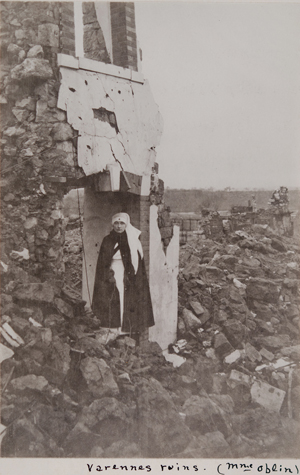Honoring the Women Who Served in WWI
Letters and photographs on display at the Massachusetts Historical Society

It was known as the “war to end all wars.” A truly global conflict, 65 million men from 40 countries fought during World War I. New technology made it possible for battles to take place in the air, for tanks to cover the battlefields, and for chemical warfare to immobilize entire squadrons. In the end, more than 8 million soldiers were killed and over 21 million were wounded. Often forgotten are the thousands of female Army nurses and Red Cross volunteers who served on the front lines, caring for the injured and witnessing firsthand the horrors of war. The Massachusetts Historical Society’s current exhibit, Letters and Photographs from the Battle Country: Massachusetts Women in the First World War, recalls the valor and sacrifice of the women from Massachusetts who served in the conflict.
The exhibition, which coincides with the 100th anniversary of the outbreak of World War I, focuses on two of the hundreds of Massachusetts women who went to France as members of the US armed forces, the Red Cross, and other war-relief organizations. It features the letters, diary entries, photographs, and other memorabilia belonging to Nora Saltonstall and Margaret Hall, both of whom served as Red Cross volunteers in France during the final years of the war. The material is drawn from the Historical Society’s permanent collection.
Saltonstall, the daughter of one of Boston’s most prominent families (her brother Leverett would become governor of Massachusetts and, later, a United States senator) was 23 when she arrived in Paris in October 1917. She aided refugees and worked in a mobile hospital unit that followed Allied troops during the German offenses in 1918, which earned her the Croix de Guerre from the French government. In a letter dated November 13, 1917, Saltonstall described the atmosphere in France to her family: “When I first got here I thought there were very few wounded but each day I notice more and more. The most evident are those minus a leg. They walk around on stumps and go very fast; a great many soldiers walk with canes. All the men look tired and very serious. It is queer to be in Paris and to see no laughing faces or to hear no foolish little quarrels on street corners; everyone goes about his business and you feel that life is much too hard to stop and laugh.”
Shortly after her return from Europe, Saltonstall traveled with friends on a tour of the western United States. She was stricken with typhoid fever in Oregon and died there. She was just 24.
Hall, a textile heiress, was 42 when she arrived in France in August 1918. She spent a year working for the Red Cross on the Western Front, and she observed the end of the war there and its immediate aftermath in Europe. The Massachusetts Historical Society has published Hall’s writing from her time overseas as well as about 275 photographs she took in France in a commemorative book, Letters and Photographs from the Battle Country: The World War I Memoir of Margaret Hall.
The assassination of Austro-Hungarian Archduke Franz Ferdinand on June 28, 1914, precipitated the “Great War”—as World War I later came to be known—which pitted the Central Powers (Germany, Austria-Hungary, and the Ottoman Empire) against the Allies (Great Britain, the United States, France, Russia, Italy, and Japan). The introduction of modern military technology led to a bloody, four-year conflict that resulted in over 9 million deaths and set the stage for further unrest in Europe over the course of the 20th century.
In response to the outbreak of war, the American Red Cross grew exponentially, recruiting more than 20,000 registered nurses to serve the American forces. Volunteers served on the front lines in France, witnessing the unprecedented violence firsthand and treating the millions of wounded Allied soldiers on the Western Front.
The exhibition is a rare look into the lives of two women during World War I, Massachusetts-born Red Cross volunteers Hall and Saltonstall. According to the Massachusetts Historical Society’s website, the letters, diary entries, and photographs on display combine to form a powerful narrative that reflects the “world of loss and trauma” that characterized the war years. For anyone interested in the intersection of history and memory, Letters and Photographs from the Battle Country is not to be missed.
Letters and Photographs from the Battle Country: Massachusetts Women in the First World War is on exhibit through January 24, 2015, at the Massachusetts Historical Society, 1154 Boylston Street, Boston. The exhibit is free and open to the public Monday through Saturday, 10 a.m. to 4 p.m. To get there, take an MBTA Green Line trolley to the Hynes Convention Center stop. From there, it is about a three-minute walk to the Historical Society.
Samantha Pickette can be reached at pickette@bu.edu.
Comments & Discussion
Boston University moderates comments to facilitate an informed, substantive, civil conversation. Abusive, profane, self-promotional, misleading, incoherent or off-topic comments will be rejected. Moderators are staffed during regular business hours (EST) and can only accept comments written in English. Statistics or facts must include a citation or a link to the citation.